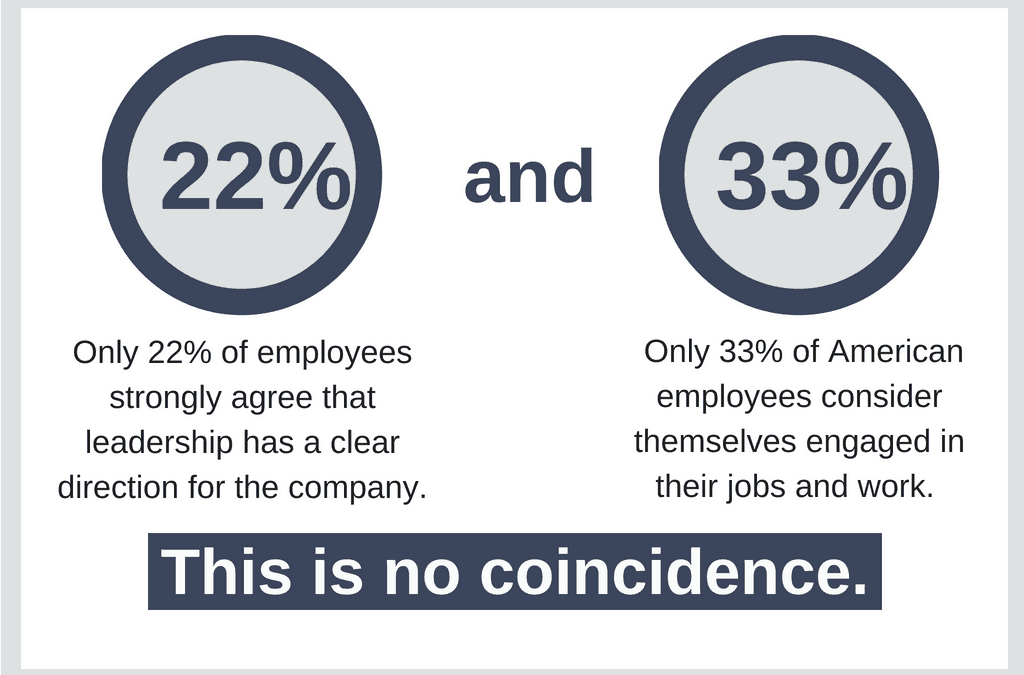Over 75% of employees surveyed don’t think their leadership has a clear vision for the future. Think they just don't get it? Think again.
What’s the problem? In most instances, Vision lacks purpose, and Strategic Objectives aren’t meaningful to employees. Bottom line, we’re just not speaking their language.
Where the Strategy Process Falls Short
Unfortunately, most companies don't spend enough energy thinking about how to communicate the corporate strategy within the context of a purposeful Vision (or a “why”) that makes it truly meaningful to their employees.
To be compelling, it must be meaningful. To be meaningful, it must be felt. If employees don't connect with the Vision, it’s far too easy for even good employees to disengage.
Too often, leaders communicate strategy only in term of goals and results that the Board of Directors or investors value. Click To Tweet
Sure, you've got to have measurable goals and objectives, but you can't engage employees and inspire a workforce to achieve excellent results with a Strategic Goal like “Increase 5% Market Share” or “Achieve 15% EBITDA”. Those goals are respectable, but let’s be clear whom those goals resonate with: the C-Suite.
You know what I’m talking about here. It’s not uncommon for C-Suite executives to receive significant bonuses upon achieving strategic goals. C-Suite executives’ jobs are on the line when goals aren't met. What happens when you go beyond the C-Suite where the execution occurs? How much does the average employee’s compensation or work-life change if the organization knocks its goals out of the park? Conversely, how many of those employees will be held personally accountable if the objectives aren’t met?
The fact is most employees were there before the CEO or President came on board, and most of those employees will be there after she leaves. “This too shall pass” can become the fallback position of employees who see strategic initiatives and leaders come and go like the latest management best practice.
To counter this state of inertia, you must upend the approach to strategic planning that has become ubiquitous in most organizations. I can help you with that! (Check out my Fulfilling Strategy framework.)
Create a Purposeful Vision
Yes, the word “Vision” can drum up painful memories of the team debating for hours over which adjective works best only to end up with a generic, super-lame Vision that no one wants to claim. It doesn’t have to be like this.
Put simply, your company’s Vision should be a purposeful answer to the question, “Why do we do what we do? Simon Sinek did a masterful job of explaining the power of this simple question in his Ted Talk, and I would encourage you to invest 18 minutes and watch his video.
People want to be a part of something bigger than themselves. That’s a universal truth and it's also your opportunity to create a Vision that is both inspiring and builds a sense of belonging.
So, what if you make widgets or something that doesn’t seem to have an intrinsically purposeful “why”? While it's more challenging to do, it shouldn't be an excuse. Case in point: Old Dominion, the transport company. On every Old Dominion truck, you will see the words:
“Helping the world keep promises.”

Now that is a powerful “why” for a few reasons.
- First, it puts the value of what Old Dominion does into terms that are compelling and meaningful.
- Second, it’s clear that the priority of the organization is to do everything possible to honor the trust customers place with Old Dominion to be the best in delivery.
- Lastly, it shows customers and employees that Old Dominion understands the work it does matters.
Ah, there’s a purpose to get behind!
I should also mention that Old Dominion is the most profitable of the top 15 transport companies boasting 13.8% Net Income.
Purpose matters. Do not short-change this part of strategic planning.
An organization’s Vision is its North Star. It points employees in the right direction and serves as the foundation for creating a culture and establishing priorities. Without the context of Vision, the other components of a strategy can seem unclear and even meaningless.
Make Strategic Objectives Meaningful
Many organizations confuse Strategic Goals and Strategic Objectives (or strategic focus), but the distinction matters. “Increase 5% Market Share over a Three-Year Period” may sound like a Strategic Objective, but it’s not. It’s a goal. A Strategic Goal is the result you want to achieve from executing strategic objectives.
Strategic Objectives are the best ways we can execute our Vision and reach our Strategic Goals over the planning period.
Let’s use losing weight as an example. Losing 10 pounds is not a strategy. It’s a Strategic Goal. “Eating a vegan diet and exercising an hour, four times a week” are Strategic Objectives for losing 10 pounds. Strategic Objectives are the overarching behaviors and actions you will take in support of your Vision.
Now let’s take our Strategic Goal “Increase 5% Market Share over a Three-Year Period” and come up with potential Strategic Objectives. What are the keystone behaviors or initiatives that are essential to achieving that goal? A few examples might be:
- Create a National Account Sales Service Model that will increase penetration with top 10 customers.
- Focus New Product Development in high growth geographies to deliver $XXXX.
Why is this important? Which provides more clarity and priority guidance to employees: (1) Increase 5% Market Share over Three-Year Period” or (2) “Focus New Product Development in High Growth Geographies to Deliver $XXX”? The latter is high-level, but it’s defined and clear enough to be meaningful and ultimately, actionable.

TIP: What’s the right number of strategic objectives? Three to seven is the most an organization can handle. I’d recommend starting with fewer and if the organization is successfully advancing the objectives AND can take on more, then add the next most important objective.

Idea into Action
Informal Survey: Put these ideas into action. Get your team together and use these survey questions as discussion points by finding out how strongly they agree with these statements:
- The leadership of our organization has a clear vision and strategy for our company.
- Our vision is meaningful to me and motivates me in my work.
- I have a clear understanding of the broader, strategic company goals.
- I see a clear link between my work and the company's goals and objectives.
- I am happy with my level of engagement in my work and job.
If you'd be interested in a more formal diagnostic survey or if you would just like to learn more about Fulfilling Strategy, contact me here.
Work well,


